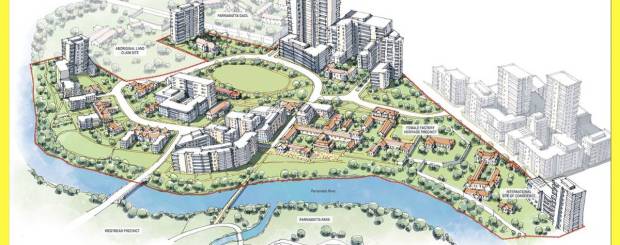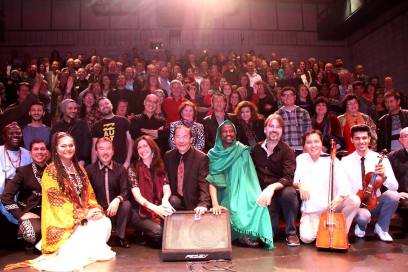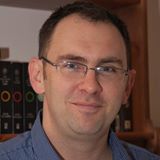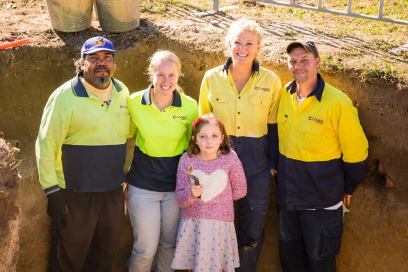 No, that headline is not a joke – nor have I swapped sides. It was my personal response after attending Discovering Parramatta North Open Day, conducted by UrbanGrowth NSW on Saturday, May 27. From informal feedback, it was a response shared by many who attended, including Parramatta National Trust. Our focus may have been different from our hosts, but the experience began to put flesh on our alternative vision for the future. The aim of Open Day was to learn about the recent archaeological discoveries on the site. Above is Parramatta Holroyd Sun’s photo of nine-year-old Hannah Bunby from Parramatta North Public School. She wants to become an archaeologist and on a school tour the day before, she met the archaeologists led by Aboriginal Jamie Eastwood, right, in the pit where they were working.
No, that headline is not a joke – nor have I swapped sides. It was my personal response after attending Discovering Parramatta North Open Day, conducted by UrbanGrowth NSW on Saturday, May 27. From informal feedback, it was a response shared by many who attended, including Parramatta National Trust. Our focus may have been different from our hosts, but the experience began to put flesh on our alternative vision for the future. The aim of Open Day was to learn about the recent archaeological discoveries on the site. Above is Parramatta Holroyd Sun’s photo of nine-year-old Hannah Bunby from Parramatta North Public School. She wants to become an archaeologist and on a school tour the day before, she met the archaeologists led by Aboriginal Jamie Eastwood, right, in the pit where they were working.
One hundred people including school students, Parramatta Female Factory Friends and hospital personnel were given a preview on the Friday. On Saturday, 300 people participated in a succession of guided tours led by members of the state government’s development agency or by other experts who are consultants to the North Parramatta Transformation Project. UrbanGrowth’s project team leader Donna Savage gave a brief overview of the project and archaeological work to date, before each tour. She was followed by Jillian Comber, consultant in Aboriginal and historical archaeology, who is leading some of the research. Archaeological teams with indigenous expertise and links to the land have been working across the site.
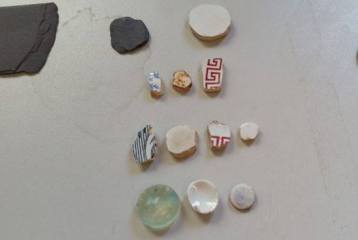 Freely available were high quality fact sheets about the sites under investigation giving detailed information on the research to date and the history either known or newly revealed. Papers included Aboriginal History and Archaeology; Aboriginal Artefacts; Water Management 1803 – 1880s – Ditches, Dykes and Drains; The Parramatta Female Factory – an Archeology of Absence; The Ward for the Criminally Insane 1861 – 1963 – Escape from Parramatta Lunatic Asylum; and Parramatta Hospital for the Insane 1878 – 1983 – Change of Name and Change of Attitude. Some of the items excavated from the sites, above. Jamie explained that more than 2000 Aboriginal artefacts have been unearthed, and that some like spear heads of silcrete, indicate that trade was conducted with other groups, because silcrete is not a local stone.
Freely available were high quality fact sheets about the sites under investigation giving detailed information on the research to date and the history either known or newly revealed. Papers included Aboriginal History and Archaeology; Aboriginal Artefacts; Water Management 1803 – 1880s – Ditches, Dykes and Drains; The Parramatta Female Factory – an Archeology of Absence; The Ward for the Criminally Insane 1861 – 1963 – Escape from Parramatta Lunatic Asylum; and Parramatta Hospital for the Insane 1878 – 1983 – Change of Name and Change of Attitude. Some of the items excavated from the sites, above. Jamie explained that more than 2000 Aboriginal artefacts have been unearthed, and that some like spear heads of silcrete, indicate that trade was conducted with other groups, because silcrete is not a local stone.
 As well as being a known Aboriginal settlement area, Parramatta North was the site of some of the colony’s first farms, from the 1790s. It was also home to early colonial institutions including the convict Parramatta Female Factory from 1818 and the Roman Catholic Orphan School from 1841, which later became the Parramatta Girls Home. Parramatta Gaol dating from the 1840s is also on this site. The Parramatta National Trust’s photo, above, of the excavated ha-ha (a deep trench with a sloping side that ends in a vertical wall), shows it was filled in with earth and old bed frames in the 1970s, denoting a change of practice in treatment of the mentally ill.
As well as being a known Aboriginal settlement area, Parramatta North was the site of some of the colony’s first farms, from the 1790s. It was also home to early colonial institutions including the convict Parramatta Female Factory from 1818 and the Roman Catholic Orphan School from 1841, which later became the Parramatta Girls Home. Parramatta Gaol dating from the 1840s is also on this site. The Parramatta National Trust’s photo, above, of the excavated ha-ha (a deep trench with a sloping side that ends in a vertical wall), shows it was filled in with earth and old bed frames in the 1970s, denoting a change of practice in treatment of the mentally ill.
Both North Parramatta Residents Action Group (NPRAG) and Parramatta Female Factory Friends were provided by organisers with tables close to the central meeting point. NPRAG displayed their artist’s impressions of UrbanGrowth’s proposed developments and of their own alternative proposals for creative arts facilities, and public open space for the benefit of community physical and mental health.  The drawing of UGNSW’s proposals, left, drew an angry response from two staff members. One claimed they were a serious misrepresentation and another stated there was a great deal of misinformation circulating. While the drawings were concept only, they were sourced from the only information available from UrbanGrowth at the time. It was stated that the high rise buildings shown on the Cumberland Hospital side of the old Parramatta Gaol are now positioned on the east side. Another change that has been made as a result of community feedback is that there will be no new residential buildings in the historic Governor Gipps courtyard.
The drawing of UGNSW’s proposals, left, drew an angry response from two staff members. One claimed they were a serious misrepresentation and another stated there was a great deal of misinformation circulating. While the drawings were concept only, they were sourced from the only information available from UrbanGrowth at the time. It was stated that the high rise buildings shown on the Cumberland Hospital side of the old Parramatta Gaol are now positioned on the east side. Another change that has been made as a result of community feedback is that there will be no new residential buildings in the historic Governor Gipps courtyard.
For some within UrbanGrowth and within the community, there is deep mutual distrust. UrbanGrowth claims misrepresentation while community members claim secrecy and planning to a hidden agenda. UrbanGrowth says it can’t display developer proposals until they have been drawn up by the developers and approved by Parramatta Council, while community members claim that UrbanGrowth won’t have control anyway if their current development application to sell off two thirds of the 30 hectare site in 17 super lots is approved. Anger and distrust foment between a rock and a hard place.
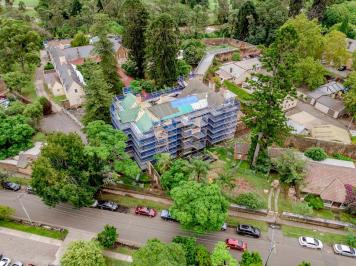 For those visiting the site, the inspiration of the day was the recognition of just how much information and evidence about our ancient and more recent past sits just below the surface of the site. It was illuminating to see what could be achieved when real money, expertise and resources are applied to archeological research and heritage building repairs. UrbanGrowth’s aerial view, above, of repairs being undertaken on the Roman Catholic Orphan School. The state government argues that only by selling two thirds of the site can it afford the conservation needed on the other third. Those of us who have lately witnessed the demolition of Parramatta Swimming Pool before any alternative plan was in the pipeline, have only to remember how quickly the government could find $30 million to match Parramatta Council’s $30 million when community anger forced them to begin planning for a new aquatic centre.
For those visiting the site, the inspiration of the day was the recognition of just how much information and evidence about our ancient and more recent past sits just below the surface of the site. It was illuminating to see what could be achieved when real money, expertise and resources are applied to archeological research and heritage building repairs. UrbanGrowth’s aerial view, above, of repairs being undertaken on the Roman Catholic Orphan School. The state government argues that only by selling two thirds of the site can it afford the conservation needed on the other third. Those of us who have lately witnessed the demolition of Parramatta Swimming Pool before any alternative plan was in the pipeline, have only to remember how quickly the government could find $30 million to match Parramatta Council’s $30 million when community anger forced them to begin planning for a new aquatic centre.
The draft Development Control Plan (DCP) and Development Application DA/1124/2016 relating to Parramatta North Urban Transformation Precinct are on display by Parramatta Council until June 13. You can make your submission online or by using the template created by NPRAG.
The Royal Australian Historical Society, The National Trust of Australia, Parramatta Female Factory Friends and NPRAG are all submitting objections to inappropriate residential development to Parramatta Council. At last year’s RAHS conference in Wollongong, NPRAG president Suzette Meade discussed the work NPRAG has carried out to protect and promote Parramatta’s heritage. Suzette’s presentation is on YouTube.
 She explains that there are over “77 state heritage listed buildings around the Cumberland Hospital grounds. The Female Factory Precinct, filled with buildings designed by government architects Francis Greenway to Walter Liberty Vernon, is undergoing a National Heritage Listing Assessment and is a more than worthy candidate to be added to the current 11 convict locations on the UNESCO world heritage listing. If sympathetically re-interpreted and re-developed, this huge site could become Australia’s equivalent of Colonial Williamsburg but with one unique advantage – it is all real, all still there physically and historically and not some modern confection channelling the past.” Another Parramatta National Trust photo, above, reveals the layers of history under the site of the Female Factory.
She explains that there are over “77 state heritage listed buildings around the Cumberland Hospital grounds. The Female Factory Precinct, filled with buildings designed by government architects Francis Greenway to Walter Liberty Vernon, is undergoing a National Heritage Listing Assessment and is a more than worthy candidate to be added to the current 11 convict locations on the UNESCO world heritage listing. If sympathetically re-interpreted and re-developed, this huge site could become Australia’s equivalent of Colonial Williamsburg but with one unique advantage – it is all real, all still there physically and historically and not some modern confection channelling the past.” Another Parramatta National Trust photo, above, reveals the layers of history under the site of the Female Factory.
 The submission developed by Parramatta Female Factory Friends highlights the absence of a Master Plan. There is a precedent for this, they write, in that the Rozelle Hospital/Callan Park grounds and buildings’ Master Plan is the result of community input and acceptance. “This must be carried out for the Cumberland Hospital site as it has a far more singular, significant and extensive history than the Rozelle Hospital.”
The submission developed by Parramatta Female Factory Friends highlights the absence of a Master Plan. There is a precedent for this, they write, in that the Rozelle Hospital/Callan Park grounds and buildings’ Master Plan is the result of community input and acceptance. “This must be carried out for the Cumberland Hospital site as it has a far more singular, significant and extensive history than the Rozelle Hospital.”
Another concern they raise, is shared by every other community organisation – the height of buildings and transfer of floor space. The height of buildings seriously impacts heritage buildings and the valued park like setting of PNHS. These must be scaled back further, they say. Setbacks must be reviewed. They also point out that the DDCP (page 26 C.3) states that floor space cannot be transferred. “The DA is not a legal document,” they say. “There is no protection for future floor space ratios (FSR) being altered by a developer.”
(A quick note – I delayed publishing this in the hope that advice about potential World Heritage Listing would arrive in time from heritage consultants to the project. There has been a delay, but it is clear that it would still be subject to the qualifications expressed in submissions, above.)
One of the great concerns among the many protests is the proposal to preserve only a selection of heritage buildings and thus destroy the continuous narrative of the site. An example is the proposal to remove buildings like those from the 1960s on the site of the Parramatta Girls Home and leave only the old Roman Catholic Orphanage and the children’s hospital, Bethel (see Parragirls’ photo, above, right). Those newer buildings represent a change of government policy, when some of the girls gained access to education.There are many potential adaptive re-uses for all these buildings.
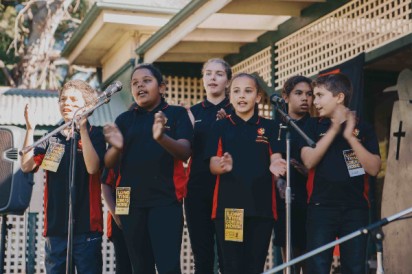 Parragirls represents girls formerly institutionalised in the Parramatta Girls Home. Under the leadership of Bonney Djuric, they have developed the Parramatta Female Factory Precinct – Memory Project. It has been evolving since 2012. One of their long term aims is to establish Australia’s first International Site of Conscience. On UrbanGrowth’s open day, they were hosting an event, Long Time Coming Home, remembering the Stolen Generations and other Indigenous Australians who were separated from their families and communities. Above is the Mt Druitt Aboriginal Children’s Choir performing at the event. Unfortunately, it was finishing by the time I could get there, but from the pleasure expressed by departing audience member it was clear that the talking circle, art, song and storytelling were a great success.
Parragirls represents girls formerly institutionalised in the Parramatta Girls Home. Under the leadership of Bonney Djuric, they have developed the Parramatta Female Factory Precinct – Memory Project. It has been evolving since 2012. One of their long term aims is to establish Australia’s first International Site of Conscience. On UrbanGrowth’s open day, they were hosting an event, Long Time Coming Home, remembering the Stolen Generations and other Indigenous Australians who were separated from their families and communities. Above is the Mt Druitt Aboriginal Children’s Choir performing at the event. Unfortunately, it was finishing by the time I could get there, but from the pleasure expressed by departing audience member it was clear that the talking circle, art, song and storytelling were a great success.
This is the whole point of this post. Rather than the rush to sell off “surplus” land by the NSW government, let us all share in exploring the potential of this remarkable site. UrbanGrowth has shown us some of the real possibilities. In the meantime, we’ve just been alerted to another stunning government fiasco – Parramatta Advertiser, May 31, 20017, pages 8 – 9. Parramatta Council has blocked the use of the Old King’s School as the temporary Parramatta Primary School, owing to serious risk of flooding from the adjoining Parramatta River. What does that say about former Premier, Mike Baird’s “thought bubble” proposal to move the Powerhouse Museum onto the nearby banks of the Parramatta River?
Three important comments have been received in the four hours since this post was published and are now added in the sequence in which they arrived:
- On Facebook from Cumberland Hospital historian Dr Terry Smith – “I have to say that I am deeply disappointed with what I’ve heard of the archeological interpretations of some of the finds on the site. Without any evidence whatsoever, one archeologist claimed in television interviews that patients were chained to the floor of the ward for the criminally insane and wiled away their days playing a harmonica. There is NO historical evidence that patients were chained to floors (or walls) of this ward. Apart from this fact, the patients in this ward were extremely dangerous and would never have been allowed a harmonica, the metal from which would have provided a easy weapon. The bedsteads were not buried in the 1870s but rather in the early 1960s when Dr Eric Hilliard wanted to remove as much of the old 19th century structures as possible that resembled a prison. This included filling in the Ha Has and demolishing the ward for the Criminally Insane and several old sandstonewalls! If these points can be so easily discounted, then one might wonder about the rigor of their other interpretations?“
- From NPRAG president Suzette Meade – “UGNSW have in fact prepared a 3D model and submitted it to the Heritage Office 18 months ago (its in the minutes of the meeting available online to view). NPRAG requested for it to be viewable to public the staffer at the time said we could only look at it on their computer screen at their offices.
We then submitted a Freedom of Information order to make it public and of course the reply was CABINET IN CONFIDENCE.
What do they have to hide ? - By email from TKD associate and senior heritage consultant Sean Williams – “Part of the Cumberland Hospital (East Campus) site (essentially the Female Factory/Lunatic Asylum Precinct) and the Norma Parker Centre/Kamballa site is currently being assessed by the Federal Government for inclusion on the National Heritage List (NHL). UrbanGrowth NSW supports the listing.The Commonwealth Department of Environment and Energy has confirmed that the NHL assessment is based on the identified heritage values of the place – ie the area nominated for inclusion on the NHL. The Federal Government does not take into consideration any current or future proposals for change unless they consider them to represent a substantial risk to the identified heritage values.In relation to world heritage listing, the Commonwealth has confirmed that the identification and assessment of the values would be expected to follow a similar rigorous approach to that for inclusion on the NHL, although the focus is on establishing whether the place has ‘outstanding universal values’. Assuming that the site is nominated and the Commonwealth is satisfied that the place meets at least one of the 10 world heritage criteria, then it can refer the nomination to the World Heritage Centre to progress its evaluation and potential future inclusion on the WHL. Again, UrbanGrowth NSW supports this listing.More about the WHL assessment process can be sourced from: http://www.environment.gov.au/heritage/about/world/world-heritage-listing-process.
You can also visit the World Heritage Centre website at: http://whc.unesco.org/
- Another significant post was added to Facebook – History B4 High Rise about Melbourne’s Abbotsford Convent

